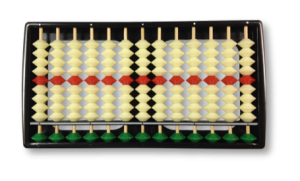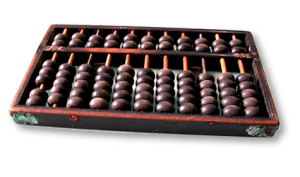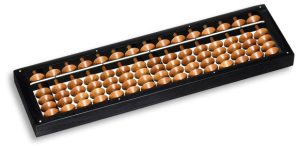 0
0
1st Generation abacus (China, 500BC)
Before the invention of the Chinese abacus, counting rods, other symbolic methods such as tally sticks, notches on bones, and the like, were undoubtedly used as a tool for counting and calculation.
The suanpan (Simplified Chinese: 算盘; Traditional Chinese: 算盤; Pinyin: suànpán, lit. “Counting tray”) of the Chinese is similar to the Roman abacus in principle, though has a different construction, and it was designed to do both decimal and hexadecimal arithmetics.
The Chinese abacus is typically around 20 cm (8 inches) tall and it comes in various widths, depending on the application and hand size of the operator. It usually has more than seven rods. There are two beads on each rod in the upper deck and five beads each in the bottom for both decimal and hexadecimal computation. The beads are usually rounded and made of a hard wood. The beads are counted by moving them up or down towards the beam. The abacus can be reset to the starting position instantly by a quick jerk along the horizontal axis to spin all the beads away from the horizontal beam at the center.
Chinese abacus can be used for functions other than counting. Unlike the simple counting board used in elementary schools, very efficient suanpan techniques have been developed to do multiplication, division, addition, subtraction, square root and cube root operations at high speed.
Bead arithmetic (Simplified Chinese: 珠算; Traditional Chinese: 珠算; Pinyin: zhùsuàn) is the calculating technique used with various types of abacus, in particular the Chinese abacus.
The similarity of the Roman abacus to the Chinese one suggests that one could have inspired the other, as there is some evidence of a trade relationship between the Roman Empire and China. However, no direct connection can be demonstrated, and the similarity of the abacus may be coincidental, both ultimately arising from counting with five fingers per hand. The standard Chinese abacus has 5 beads plus 2 for decimals, allows for more challenging arithmetic algorithms than the Roman model, and also allows for use with a hexadecimal numeral system.
2nd generation abacus (Japan, 14th Century)
Soroban (算盤, lit. “Counting tray”) is a Japanese-modified version of the Chinese abacus (算盤). The Japanese first eliminated one bead from the upper deck and later another bead from the lower deck in each column of the Chinese abacus, making the Japanese abacus purely for the decimal system. The Japanese also eliminated the use of the Qiuchu (Chinese division table). However, the Chinese division table was still used when there were 5 lower beads. There came the debate of the multiplication table versus the division table, with the school of multiplication table prevailing in the 1920s. The rods (number of digits) usually increase to 21, 23, 27 or even 31, thus allowing calculation for more digits or representations of several different numbers at the same time. The soroban is about 8 cm (3 inches) tall. The beads on a soroban are usually shaped as a double cone (bi-cone) to facilitate ease of movement.
Soroban is taught in primary schools as a part of lessons in mathematics because the decimal numerical system can be demonstrated visually. When teaching the soroban, a song-like instruction is given by the teacher. Often, primary school students may bring along with them two sorobans, one with 1 upper bead and 5 lower beads, the other with 1 upper bead with 4 lower beads. Despite the advent of handheld calculators, some parents send their children to private tutors to learn soroban because proficiency in soroban calculation can be easily converted to mental arithmetic at a highly advanced level.
On November 12, 1946 a contest between the Japanese soroban and an electric calculator was held in Tokyo. The soroban won 4 to 1.

3rd generation abacus (Singapore, 2005)
In 2005, Mdm Chee Geok Hwa created the 3rd Generation 2-in-1 Abacus, which is a break through from the traditional abacus or Soroban, with revolutionary teaching method.
It is made up of columns of 9 beads, and can be learnt very easily, utilising only 2 sets of formulas, instead of 6 sets of formulas needed to work on the soroban abacus. This allow students to relate better to their school Mathematics calculation method.
With the invention of third generation abacus, it makes learning abacus and calculation more straightforward and easy for young children to understand. It saves the time in learning the foundation, and reduces the time taken to go into mental calculation.
This abacus although is young in age, it has already proved it’s learning efficiency where students are able to complete the foundation training faster, and are able to reach to the international degree standard too!




